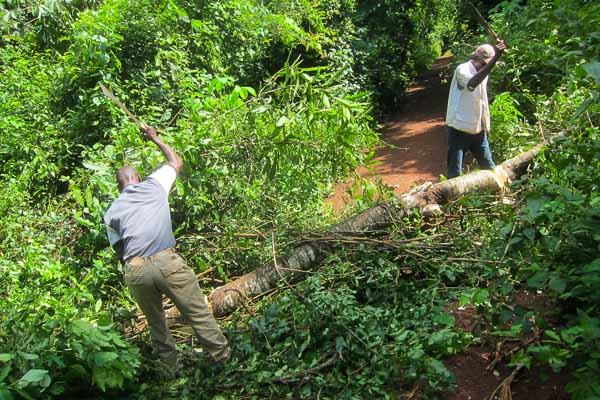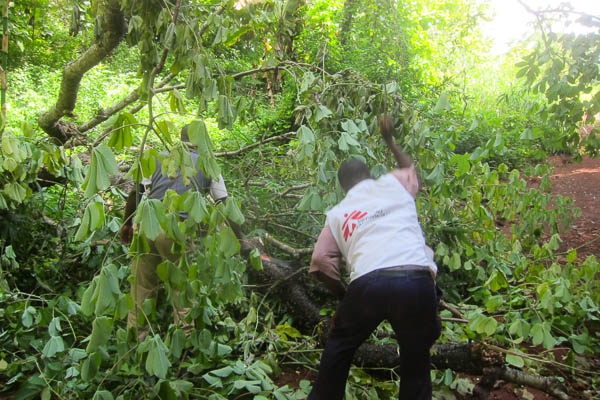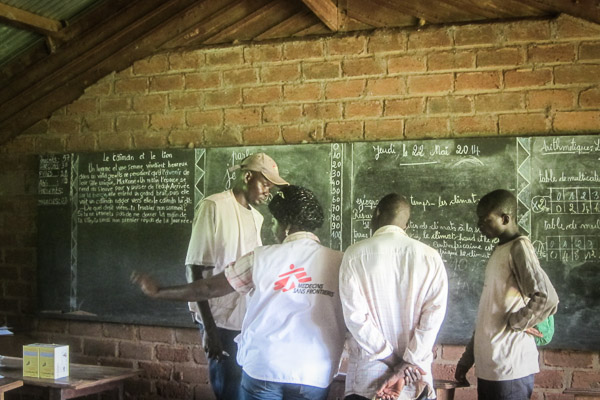[This post is being published out of order; the story is from mid-August 2014]
On August 13th, I accompanied three medical staff and a driver for a mobile clinic in Yamalé, a village on the road that leads from Bambari to Bakala in Ouaka préfecture, Central African Republic (CAR). Yamalé had, until very recently, been deserted; the population spent months living in the bush. We had already visited the village the previous day – August 12th – to resupply the “point palu”, which translates as “malaria point” – basically, MSF trains a small number of people in the local community and equips them to carry out rapid diagnostic tests for malaria, the leading cause of death in the region. We also supply medicine so they can hand out treatment to those who test positive, free of charge. In addition to resupplying the point palu, our visit would allow us to announce the mobile clinic we had planned for the following morning, asking the villagers to clean the school and cut the tall grass for us to use.
Only thirty-odd kilometres northwest of Bambari by road, you might expect the drive, in good weather and remarkably light traffic, to take about half an hour. The condition of the dirt road, however, lengthens the journey to nearly two hours, and that’s before accounting for the trees. While it’s beautiful driving through the dense green forests in CAR, the logs lying horizontally across the road are moderately annoying. Luckily we only encountered two such obstacles. The first tree took over twenty minutes to hack apart, while the second one was cleared within less than ten.
Clearing the road was a useful exercise, which would save a lot of time the next morning. Once we arrived in Yamalé, Eric and Gladys discussed medical stuff with the local point palu guys, restocked their metal trunk with malaria medicine, and then we turned around and headed back to Bambari.
We arrived shortly before 8am and over the next seven hours I drew droplets of blood from over two hundred people – mostly screaming children – to screen for malaria. Among the children, almost every single one tested positive for the mosquito-borne parasites, and a huge number of the adults tested positive as well.
The other person striking fear into the hearts of the children of Yamalé was Brice, our driver. Together, we tested between four and five hundred people for malaria, most of whom continued on to the next rooms for consultations.
As we sat in front of the village school stabbing people’s middle fingers, Anti-Balakas loitered around the centre of Yamalé, standing and sitting beside the main road less than a hundred metres in front of us. With long rifles slung over their shoulders, machetes in multi-coloured sheaths strapped to their backs or hanging from their hips, magical charms and amulets strung round their necks and taped to the foreheads of some, the Anti-Balakas are strikingly special in their outward appearance to those of us who doubt the protection offered by their magical machetes. Having been boiled in a very special herbal mixture, the machete’s flimsy steel blade is capable of stopping bullets. I wonder, however, if these boys took the time read the small print in the instruction manual: only stops bullets thrown by hand.
We considered the mobile clinic a great success. Each person was screened for malaria, and most of them also saw one of our medical staff for a consultation. Each person diagnosed with malaria received the appropriate medicine (a highly effective combination of artemether and lumefantrine) from an MSF medic. For these and other medicines prescribed, MSF staff supervised first doses on-site, explaining how much and how frequently to take them.
Our midwife held thirty consultations for expecting mothers, and the two nurses altogether consulted 375 patients. Among the more common health complaints compounding the impact of malaria, the nurses diagnosed many cases of worms, amoebic dysentery, various skin infections, upper respiratory tract infections, and bilharzia. While these conditions are all endemic in CAR, the rates seen in our mobile clinics are higher than we would expect if the people were not forced to live in the bush for months at a time, unable to protect themselves against the mosquitoes’ nightly feasts, forced to drink from murky waterways because they’re too afraid to return to their village wells, unable to reach a health post to access treatment because they feared being attacked en route. Those who aren’t afraid often cannot return home because their mud brick homes are roofless: armed groups routinely lighted the highly combustible archetypal thatched roofs on fire as a means of terrifying the population.
Large-scale arson seems to have stopped (to put it differently, the fire has ceased) in the area, though nobody can say with any certainty that it will not reignite again in the near future. Regardless, until the rains give way to the dry season toward the end of October, it’s too time-consuming to gather enough dry grass for new roofing, a circumstance motivating many villagers to remain in the bush for the time being.
At the end of the day, it was clear to me that the villagers urgently needed the medical care we were able to provide in the Yamalé mobile clinic, and they were demonstrably appreciative of our efforts, thanking us over and over for coming to help them. However, as I finished off a piece of stale bread and a handful of roasted peanuts on the three-hour drive back to Bambari, drifting in and jolting out of sleep, I wondered: will this kind of short-term medical activity have any lasting impact?
Before I could work out an answer, my eyelids dragged my chin down toward my chest, and my dirt track nap nodding began anew.





